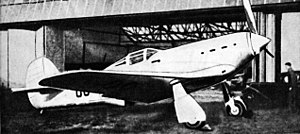Renard R.36
| R.36 | |
|---|---|

| |
| Role | Fighter |
| Manufacturer | Renard |
| Designer | Alfred Renard |
| First flight | 5 November 1937 |
| Number built | 1 |
The Renard R.36 was a Belgian all-metal fighter aircraft designed by Alfred Renard to replace the Fairey Firefly IIM within the Belgian Air Force. Designed to improve on the Renard Epervier, which was never adopted by the Belgian government, the prototype R.36 first flew on 5 November 1937.[1] Following testing the R.36 was selected by the Belgian Air Force in late 1938, with 40 aircraft provisionally ordered, to be delivered in two years.[2]
However, on 17 January 1939 the prototype, OO-ARW, crashed near Nivelles, killing pilot Lt. Viscount Eric de Spoelberch. The official investigation was inconclusive, no evidence of material failure being discovered, with the most probable causes being radio equipment coming loose during a high-G manoeuvre, jamming the controls, or the pilot becoming incapacitated. The airframe had accumulated 75:30 hours' flight time. The order was then dropped in favour of licence production of the Hawker Hurricane by SABCA.[3]
Variants
R.36
Single-seat fighter powered by a 680 kW (910 hp) Hispano-Suiza 12Ycrs engine, one built.[4] Planned armament was 4 × 7.7 mm FN Browning machine guns and 1 × 20 mm autocannon.[5]
R.37
Version of R.36 powered by a 820 kW (1,100 hp) Gnome-Rhône 14N-21 radial engine, one aircraft captured by German forces in May 1940.[6] Planned armament was 4 × 7.7 mm FN Browning machine guns and 2 × 13.2 mm FN Browning shell firing guns.[7]
R.38
Derivative of R.36 aircraft powered by a 770 kW (1,030 hp) Rolls-Royce Merlin II. One built, which was first flown on 4 August 1939 reaching a speed of 326 mph (525 km/h) during testing. Prototype evacuated to France but captured by German forces and scrapped.[6] Planned armament was 4 × 7.7 mm FN Browning machine guns and 2 × 13.2 mm FN Browning shell firing guns.[8]
R.40
Former unfinished R.36 aircraft completed with a Merlin engine following French interest, not finished and components captured by German forces.
R.42
Twin fuselage variant of the R.38, similar to the F-82 Twin Mustang. Proposed armament was four 13.2 mm FN Browning shell firing guns or four 20 mm autocannons. Existed only on paper.[9]
Operators
Specifications (R.36)
Data from [4]
General characteristics
- Crew: 1
- Length: 8.8 m (28 ft 10 in)
- Wingspan: 11.64 m (38 ft 2 in)
- Height: 2.9 m (9 ft 6 in)
- Wing area: 20 m2 (220 sq ft)
- Empty weight: 1,770 kg (3,902 lb)
- Gross weight: 2,470 kg (5,445 lb)
- Powerplant: 1 × Hispano-Suiza 12Ycrs V-12 liquid-cooled piston engine, 680 kW (910 hp)
- Propellers: 3-bladed variable-pitch propeller
Performance
- Maximum speed: 505 km/h (314 mph, 273 kn) at 3,000 m (9,843 ft)
- Range: 1,000 km (620 mi, 540 nmi)
- Time to altitude: 4,000 m (13,123 ft) in 4 minutes 56 seconds
Armament
- Guns: 1 × engine mounted 20 mm (0.787 in) cannon, 4 × wing-mounted 7.7 mm (0.303 in) machine guns
See also
Aircraft of comparable role, configuration, and era
References
- ^ de Wulf 1977, p. 186
- ^ de Wulf 1977, pp. 186–187
- ^ de Wulf 1977, p. 187
- ^ a b Green & Swanborough 1994, pp. 490–491
- ^ "Microsoft Word - Renard_R36.doc" (PDF). fnar.be. Retrieved 2022-01-03.
{{cite web}}: CS1 maint: url-status (link) - ^ a b Green & Swanborough 1994, p. 491
- ^ "Microsoft Word - Renard_R37.doc" (PDF). fnar.be. Retrieved 2022-01-02.
{{cite web}}: CS1 maint: url-status (link) - ^ "Armament of R.38" (PDF).
{{cite web}}: CS1 maint: url-status (link) - ^ "Belgian Beauties; The Renard Fighters". youtube.com. Retrieved 2022-01-03.
{{cite web}}: CS1 maint: url-status (link)
- Green, William; Swanborough, Gordon (1994). The Complete Book of Fighters. London: Salamander. ISBN 1-85833-777-1.
- de Wulf, Herman (April 1977). "Renard's Neutrality Fighters". Air International. Vol. 12, no. 4. pp. 185–188.

